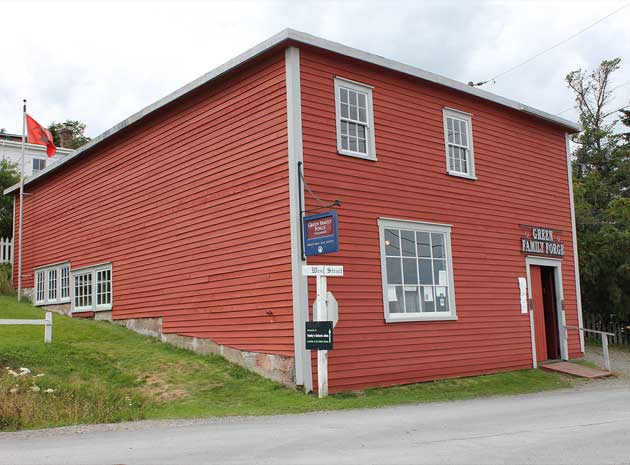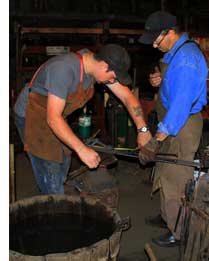 The Green family practiced as blacksmiths in Trinity since before 1750. The death of John Green is recorded in the Church records for 1764.
The Green family practiced as blacksmiths in Trinity since before 1750. The death of John Green is recorded in the Church records for 1764.
The present smithy was built between 1895 and 1900. It was last in use in 1955. The building is unusually large for that era with a second storey along the front of the structure.
A shallow well at the back wall supplied the water needed for cooling forged items made of iron. The supply was always clear and cool and was a favourite place for people to get a cool drink or to get water to boil their kettle.
Up to four blacksmiths worked at the same time using two forges. The forges were coal fired. The bellows were pumped by hand. The tools were also hand driven. Many of them were handmade for specific purposes or jobs. Electricity did not come until 1955, so all work was done with the light of the fire and one kerosene lamp.
The forge was a wonderful social centre. People seemed drawn to the fire and just about anything was discussed.
Many people think of the blacksmith as being most useful in an agricultural society, both as a farrier and as someone who would repair agricultural equipment. However, the main work at the Green Family Forge involved boats and schooners. The arrival of the schooners getting ready for the Labrador fishery was a time of great activity and importance.
In 1991, the forge was restored and opened as a museum. On June 3, 1991, the Forge was registered as a Heritage Structure by the Heritage Foundation of Newfoundland and Labrador. In 1998, the Trinity Historical Society was given the Southcott Award by the Newfoundland Historic Trust for the restoration of the forge.
In 1999, the forge once again became operational. A blacksmith was hired and demonstrations were conducted. In 2004, the Society received the prestigious Manning Award from the Historic Sites Association of Newfoundland and Labrador for work surrounding the forge.
Association of Newfoundland and Labrador for work surrounding the forge.
The forge has become one of the “must see” historic sites and produces items for sale such as fireplace pokers, letter openers, roasting forks, candle holders, coat hooks, sign brackets, hinges and planters. To view some of these items please click here.
For more information on the Green Family Forge, visit the Community Stories exhibit “The Work of the Blacksmith” within the Virtual Museum of Canada online site.
The Green Family Forge is open from June 2 to October 12 from 9:30 am - 5:00 pm daily. The price of admission is $23.00 per adult. Seniors and Students $18.00 per person. Children and Youth 16 years and younger are admitted free of charge. Admission includes entry to eight historic sites in the Town: the Visitors Centre, Lester-Garland House, Lester-Garland Premises (Ryan’s Shop), Cooperage, Green Family Forge, Hiscock House, Trinity Museum and Fort Point.
Visitors may purchase their Trinity Experience pass at Fort Point or the Lester-Garland House.


